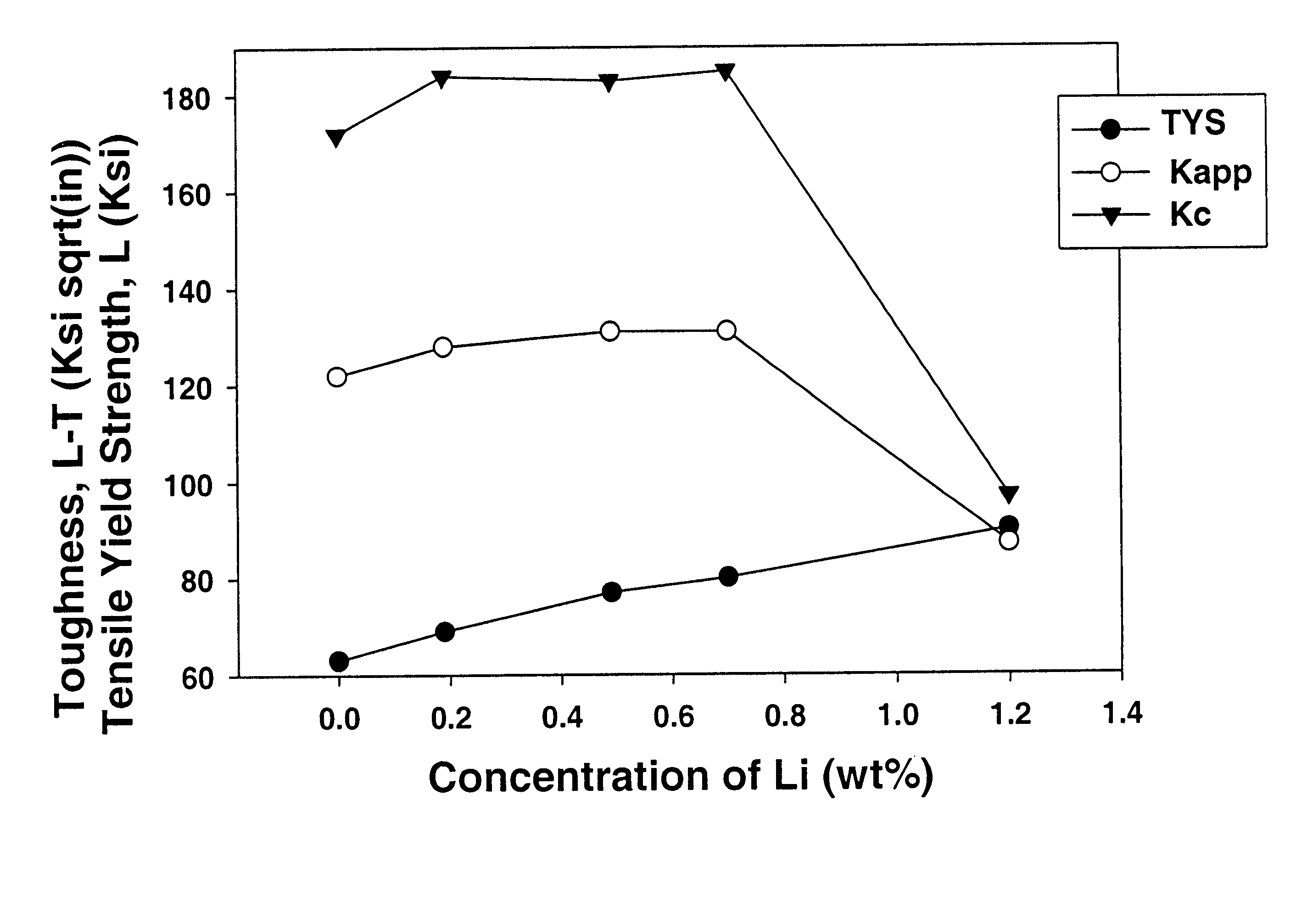Aluminum-copper-magnesium alloys having ancillary additions of lithium
a technology of copper-magnesium alloys and lithium-containing alloys, which is applied in the field of aluminum alloys, can solve the problems of insufficient combined strength and fracture toughness of such alloys, and difficult casting of such conventional alloys containing relatively high amounts of lithium, and achieves the effects of high fracture toughness, high strength, and equivalent or improved fatigue crack growth resistan
- Summary
- Abstract
- Description
- Claims
- Application Information
AI Technical Summary
Benefits of technology
Problems solved by technology
Method used
Image
Examples
example 1
[0047]Five Al—Cu—Mg based alloys with varying amounts of Li having compositions as listed in Table 2 were cast as ingots.
[0048]
TABLE 2Measured Compositions of Cast IngotsAlloy No.CuMgLiAgMnZrSiFe14.00.76—0.490.30.110.060.0423.90.740.190.490.30.110.020.0334.00.790.490.500.30.110.020.0344.10.750.700.500.30.110.020.0354.10.781.200.500.30.110.020.03
[0049]The ingots listed in Table 2 were then fabricated into plate and sheet. Based on calorimetric analyses, the ingots were homogenized as follows. For alloys 1, 2 and 3: the ingots were heated at 50° F. / hr to 905° F. (16 hours), then soaked at 905° F. for 4 hours, then heated in 2 hours to 970° F. and soaked for 24 hours. Finally, the ingots were air cooled to room temperature. For alloys 4 and 5: the ingots were heated at 50° F. / hour to 905° F. (16 hours), soaked at 905° F. for 8 hours, then heated in 2 hours to 940° F. and soaked for 48 hours prior to air cooled to room temperature.
[0050]All ingots were the heated to 940° F., and hot rol...
example 2
[0059]An ingot of an aluminum-copper-magnesium alloy having the following composition was cast (remainder is aluminum and incidental impurities):
[0060]
INGOT NO. 1SiFeCuMnMgZnZr0.030.033.240.581.3200.11
Material fabricated from this ingot is designated Alloy A.
[0061]After this, the remaining molten metal was re-alloyed (i.e., alloying again an alloy already made) by adding 0.25% lithium to create a target addition of 0.25 weight percent lithium. A second ingot was then cast having the following composition (remainder is aluminum and incidental impurities):
[0062]
INGOT NO. 2LiSiFeCuMnMgZnZr0.190.030.043.410.611.2800.1
Material fabricated from this ingot will be designated Alloy B hereinafter in this example.
[0063]Ingot No. 3 was created by re-alloying the remaining molten metal after casting Ingot No. 2 and then adding another 0.25 weight percent lithium to create a total target addition of 0.50 weight percent lithium. Ingot No. 3 had the following composition (remainder is aluminum and ...
PUM
| Property | Measurement | Unit |
|---|---|---|
| Percent by mass | aaaaa | aaaaa |
| Percent by mass | aaaaa | aaaaa |
| Percent by mass | aaaaa | aaaaa |
Abstract
Description
Claims
Application Information
 Login to View More
Login to View More - R&D
- Intellectual Property
- Life Sciences
- Materials
- Tech Scout
- Unparalleled Data Quality
- Higher Quality Content
- 60% Fewer Hallucinations
Browse by: Latest US Patents, China's latest patents, Technical Efficacy Thesaurus, Application Domain, Technology Topic, Popular Technical Reports.
© 2025 PatSnap. All rights reserved.Legal|Privacy policy|Modern Slavery Act Transparency Statement|Sitemap|About US| Contact US: help@patsnap.com



